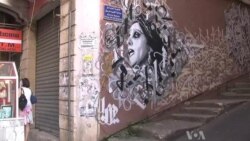BEIRUT —
During Lebanon's 15-year civil war, territorial markings became commonplace. They separated neighborhoods along sectarian lines, using symbols, flags and portraits of political leaders. Today, a rise in sectarian tensions in Lebanon fueled by the war in neighboring Syria, has contributed to an increase in political and social graffiti.
Barely a wall in Beirut is untouched. From murals to political messages to advertisements, the walls are serving as a place for public dialogue and political debate.
Whether it's a message against the Turkish annexation of Western Armenia, or denouncing rape, or protesting the war in Syria, these days it seems everyone has something to say.
"No to the extension" says one message, referring the Lebanese Parliament's recent decision to extend its term for another 17 months. Below it, a continuation: "not even one day."
Graffiti allow people to voice their frustration according to graffiti artist Yazen Halwani, 20. He is having the first-ever solo show for a graffiti artist, entitled 'Joumhouriat el Mouz', which means 'Banana Republic'.
"A banana republic is a system where you have very few people governing the country and it's corrupt and this is exactly an illustration of Lebanon," he explained.
Graffiti artists -- both amateur and professional -- have written about the war in neighboring Syria. But many messages -- both for and against the regime -- have been removed or crossed out. Halwani says that inspires graffiti artists to get more creative.
"The most important thing is that the political views should not be blunt, should not be childish, and especially should not be very aggressive," Halwani said.
Graffiti were not always so nuanced. Public space in Lebanon used to be occupied by inscriptions and stencils related to war and sectarian politics, explained Tania Helou, who has studied civil war graffiti.
"It was a way to impose a geographic territory for each party, or each neighborhood, or each military faction," she said.
Evidence of those markings remain in Ain el-Rammaneh -- a low income Christian neighborhood covered with symbols of a political party called "The Lebanese Forces".
Residents like Joseph Elias Harb say it makes them feel protected.
"The love of the leaders is always in our hearts, but when you see the graffiti of your leader next to you, you feel more comfortable," he said.
Tania Helou said that for the most part, messages have evolved away from religious, military and ideological topics to become more social and environmental.
But whether artistic or militant, as sectarian lines become more strongly etched in the psyches of Lebanese, conversations that cannot be had on the streets are increasingly etched on city walls.
Barely a wall in Beirut is untouched. From murals to political messages to advertisements, the walls are serving as a place for public dialogue and political debate.
Whether it's a message against the Turkish annexation of Western Armenia, or denouncing rape, or protesting the war in Syria, these days it seems everyone has something to say.
"No to the extension" says one message, referring the Lebanese Parliament's recent decision to extend its term for another 17 months. Below it, a continuation: "not even one day."
Graffiti allow people to voice their frustration according to graffiti artist Yazen Halwani, 20. He is having the first-ever solo show for a graffiti artist, entitled 'Joumhouriat el Mouz', which means 'Banana Republic'.
"A banana republic is a system where you have very few people governing the country and it's corrupt and this is exactly an illustration of Lebanon," he explained.
Graffiti artists -- both amateur and professional -- have written about the war in neighboring Syria. But many messages -- both for and against the regime -- have been removed or crossed out. Halwani says that inspires graffiti artists to get more creative.
"The most important thing is that the political views should not be blunt, should not be childish, and especially should not be very aggressive," Halwani said.
Graffiti were not always so nuanced. Public space in Lebanon used to be occupied by inscriptions and stencils related to war and sectarian politics, explained Tania Helou, who has studied civil war graffiti.
"It was a way to impose a geographic territory for each party, or each neighborhood, or each military faction," she said.
Evidence of those markings remain in Ain el-Rammaneh -- a low income Christian neighborhood covered with symbols of a political party called "The Lebanese Forces".
Residents like Joseph Elias Harb say it makes them feel protected.
"The love of the leaders is always in our hearts, but when you see the graffiti of your leader next to you, you feel more comfortable," he said.
Tania Helou said that for the most part, messages have evolved away from religious, military and ideological topics to become more social and environmental.
But whether artistic or militant, as sectarian lines become more strongly etched in the psyches of Lebanese, conversations that cannot be had on the streets are increasingly etched on city walls.










